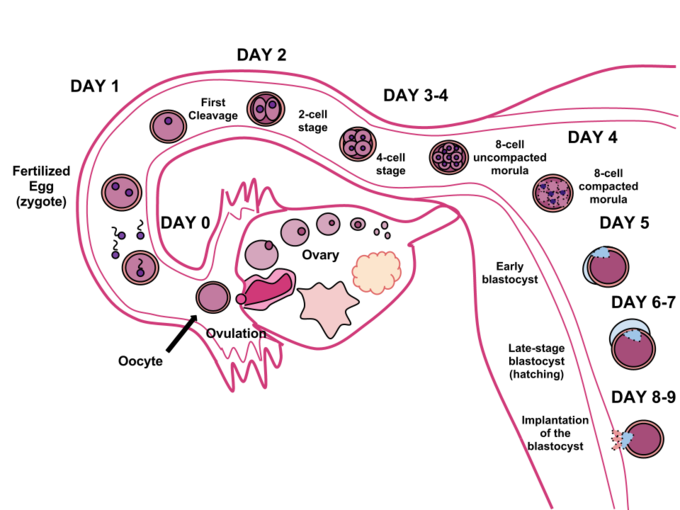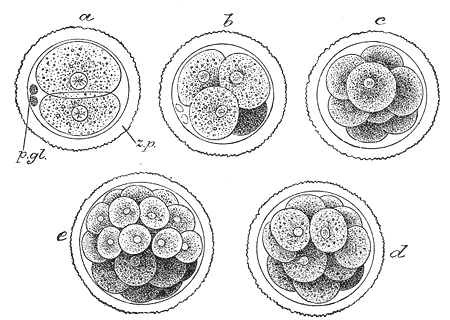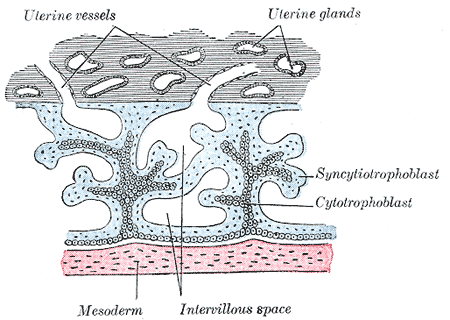受精(Fertilization)
当精子和卵细胞结合产生合子(或者是)受精卵时,这就是受精过程。当受精卵向子宫移动时,开始分裂过程。
基因解码准备
了解人的受精过程
受精过程的核心要点
要点
- 受精通常叫做怀孕,一旦受精卵在子宫内壁上着床,妊娠就开始了。
- 精子和卵细胞的结合通常在性交后发生,但是人工受精和体外受精可以在没有性交活动的情况下实现妊娠。
- 受精过程由多个buchou组成,任何一步发生障碍都会导致妊娠失败。
- 在受精前,精子在女性生殖道的环境的刺激下,通过获能增加运动能力、降低细胞膜的稳定性,使得精子的头部可以进入卵子。
人体疾病及表征术语(Key Terms)
- 受精(fertilization): 精子和卵细胞的集合过程。
- 获能(capacitation): 精子在女性生殖里获得进入使卵细胞受精的能力的过程。
- 植入(implantation): 受精卵嵌合进入子宫壁的过程。
- 不分离(Nondisjunction): 在细胞分裂过程中,同源染色体和姊妹染色单体没有正常分离的现象。
- 合子(zygote): 受精的卵细胞。
如果妊娠过程是从植入开始,导致妊娠的雌性配子或者是卵细胞与雄性配子或者是精子的结合则发生在更早的时候。在医学上,这个过程叫做受精,用非专业的话来讲,也就是通俗的说,就是受孕。
受精后,雄性配子和雌性配子的结合产物被称为合子或者受精卵。对于人来说,采用的是体内受精过程,雌性和雄性配子的结合实际上发生在性交之后。
但是,人工受精和体外受精的出现,使得没有性交过程也可以开启妊娠。这个方法可以是自愿选择,也可以是因为不育的原因。

人类的受精: 精子和卵细胞通过受精而结合产生合子,在8天左右,合子植入到子宫壁上,长达9个月。
受精过程有多个bucu,其中任何一个收到干扰都会导致失败。在这个过程的开始,精子经过一系列的变化,因为刚刚射出的精子不能够受精,或者受精能力不足。
精子在女性生殖道里,经过几个小时的获能的过程,增加运动能力,降低膜的稳定性。通过降低膜的稳定性,精子为顶体反应做好准备。顶体反应穿过坚硬的透明带膜的酶促反应过程。精子和从两个卵巢中的一个释放出来的卵细胞在输卵管(fallopian tubes)结合。
受精卵,又称为合子,然后移动到子宫,这个行程需要近一个星期的时间,才能植入到子宫壁上。通过受精,卵细胞活化,开启发育过程,完成第二次减数分裂,两个单倍体核结合在一起形成新的二倍体的基因组。
减数分裂过程中的不分离及从合子到囊胚的早期分裂过程的出现的问题会导致无法植入或者是妊娠失败。
Cleavage of the Zygote
The process of cleavage is the step of embryogenesis where the zygote divides to produce a cluster of cells known as the morula.
LEARNING OBJECTIVES
Describe cleavage of the zygote
KEY TAKEAWAYS
Key Points
- Following fertilization a series of rapid cell divisions occur that decrease the cells’ size with each subsequent division—this eventually produces a morula. The different cells derived from cleavage, up to the blastula stage, are called blastomeres.
- For species such as humans, there is little yolk in eggs, and the divisions are relatively symmetrical, or holoblastic.
- For other species, such as birds and reptiles, the presence of yolk dictates uneven meroblastic divisions that produce cells of uneven size and distribution.
- The end of cleavage is known as the midblastula transition and coincides with the onset of zygotic transcription.
- The cells of the morula are at first closely aggregated, but quickly become arranged into an outer or peripheral layer, the trophoblast, which does not contribute to the formation of the embryo proper, and an inner cell mass from which the embryo develops.
Key Terms
- cleavage: In embryology, this is the division of cells in the early embryo.
- trophoblast: The membrane of cells that forms the wall of a blastocyst during early pregnancy and provides nutrients to the embryo, and later develops into part of the placenta.
- zygote: A fertilized egg cell.
- morula: A spherical mass of blastomeres that forms following the splitting of a zygote; it becomes the blastula.
Cell division with no significant growth that produces a cluster of cells that is the same size as the original zygote, is called cleavage. At least four initial cell divisions occur, resulting in a dense ball of at least sixteen cells called the morula.
The different cells derived from cleavage up to the blastula stage are called blastomeres. Depending mostly on the amount of yolk in the egg, the cleavage can be holoblastic (total) or meroblastic (partial).

Cell cleavage: Early development is characterized by cleavage of the zygote, which refers to cell divisions that are not associated with significant growth of the embryo.
Holoblastic cleavage occurs in animals with little yolk in their eggs. These species, such as humans and other mammals, receive nourishment as embryos from the mother via the placenta or milk after birth.
On the other hand, meroblastic cleavage occurs in animals whose eggs have more yolk, such as birds and oviparous reptiles (although some viviparous reptiles also exist). Since cleavage is impeded by the vegetal pole, there is a very uneven distribution and size of cells. Cells are more numerous and smaller at the animal pole of the zygote than at the vegetal pole.
In holoblastic eggs, the first cleavage always occurs along the vegetal–animal axis of the egg, and the second cleavage is perpendicular to the first. From here, the spatial arrangement of blastomeres can follow various patterns, due to different planes of cleavage in various organisms.The end of cleavage is known as the midblastula transition and coincides with the onset of zygotic transcription.
In amniotes, the cells of the morula are at first closely aggregated. However, they quickly become arranged into an outer or peripheral layer, the trophoblast, and an inner cell mass. The trophoblast does not contribute to the formation of the embryo proper; the embryo develops from the inner cell mass.
Fluid collects between the trophoblast and the greater part of the inner cell mass, and thus the morula, is converted into the blastodermic vesicle (also called the blastocyst or blastula). The inner cell mass remains in contact with the trophoblast at one pole of the ovum. This is named the embryonic pole, since it indicates the location where the future embryo will develop.
In the case of monozygotic twins (derived from one zygote), a zygote divides into two separate cells (embryos) at the first cleavage division. Monozygotic twins can also develop from two inner cell masses.
A rare occurrence is the division of a single inner cells mass giving rise to twins. However, if one inner cell mass divides incompletely, the result is conjoined twins. Dizygotic twins is the development of two embryos from two different zygotes.
Blastocyst Formation
The blastocyst forms early in embryonic development and has two layers that form the embryo and placenta.
LEARNING OBJECTIVES
Outline the process of blastocyst formation
KEY TAKEAWAYS
Key Points
- The human blastocyst possesses an inner cell mass (ICM), or embryoblast, which subsequently forms the embryo, and an outer layer of cells, or trophoblast, which later forms the placenta.
- The trophoblast surrounds the inner cell mass and a fluid-filled, blastocyst cavity known as the blastocoele or the blastocystic cavity. The trophoblast combines with the maternal endometrium to form the placenta in eutherian mammals.
- Before gastrulation, the cells of the trophoblast become differentiated into two strata: the ectoderm of the chorion plays a role in the development of the placenta, and the endoderm differentiates and quickly assumes the form of a small sac, called the yolk sac.
- The embryoblast is the source of embryonic stem cells and gives rise to all later structures of the adult organism.
- The floor of the amniotic cavity is formed by the embryonic disk, which is composed of a layer of prismatic cells, and the embryonic ectoderm, which is derived from the inner cell mass and lies in opposition to the endoderm.
Key Terms
- embryonic disk: The floor of the amniotic cavity is formed by the embryonic disk (or disc) that is composed of a layer of prismatic cells called the embryonic ectoderm. It is the part of the inner cell mass from which the embryo is developed.
- blastocyst: An early form in the development of an embryo that consists of a spherical layer of cells filled with fluid.
- gastrulation: The stage of embryonic development when a gastrula is formed from the blastula by the inward migration of cells.
- eutherian: Refers to all species of which the female gives birth to live young that receive prenatal nourishment via the placenta.
In humans, the blastocyst is formed approximatelyy five days after fertilization. This stage is preceded by the morula. The morula is a solid ball of about 16 undifferentiated, spherical cells. As cell division continues in the morula, the blastomeres change their shape and tightly align themselves against each other. This is called compaction and is likely mediated by cell surface adhesion glycoproteins.
The blastocyst possesses an inner cell mass (ICM), or embryoblast, which subsequently forms the embryo, and an outer layer of cells, or trophoblast, which later forms the placenta. The trophoblast surrounds the inner cell mass and a fluid-filled, blastocyst cavity known as the blastocoele or the blastocystic cavity.
The embryoblast is the source of embryonic stem cells and gives rise to all later structures of the adult organism. The trophoblast combines with the maternal endometrium to form the placenta in eutherian mammals.

Blastocyst: The blastocyst possesses an inner cell mass from which the embryo will develop, and an outer layer of cells, called the trophoblast, which will eventually form the placenta.
Before gastrulation, the cells of the trophoblast become differentiated into two strata. The outer stratum forms a syncytium, which is a layer of protoplasm studded with nuclei that shows no evidence of subdivision into cells (termed the syncytiotrophoblast).
The inner layer, the cytotrophoblast or layer of Langhans, consists of well-defined cells. As already stated, the cells of the trophoblast do not contribute to the formation of the embryo proper; they form the ectoderm of the chorion and play an important part in the development of the placenta.
On the deep surface of the inner cell mass, a layer of flattened cells, called the endoderm, is differentiated and quickly assumes the form of a small sac, called the yolk sac. Spaces appear between the remaining cells of the mass and, by the enlargement and coalescence of these spaces, a cavity called the amniotic cavity is gradually developed.
The floor of this cavity is formed by the embryonic disk, which is composed of a layer of prismatic cells called the embryonic ectoderm. This layer is derived from the inner cell mass and lies in opposition to the endoderm.
Implantation
Implantation is the very early stage of pregnancy at which the embryo adheres to the wall of the uterus and begins to form the placenta.
LEARNING OBJECTIVES
Outline the process of implantation in pregnancy
KEY TAKEAWAYS
Key Points
- At this stage of prenatal development the embryo is a blastocyst. In humans, implantation of a fertilized ovum occurs between 6 to 12 days after ovulation.
- In preparation for implantation, the blastocyst sheds its outside layer, the zona pellucida, and is replaced by a layer of underlying cells called the trophoblast. The trophoblast will give rise to the placenta after implantation.
- During implantation, the trophoblast differentiates into two distinct layers: the inner cytotrophoblast, and the outer syncytiotrophoblast. The syncytiotrophoblast then implants the blastocyst into the endometrium by forming finger-like projections into the uterine wall called chorionic villi.
Key Terms
- endometrium: The mucous membrane that lines the uterus in mammals and in which fertilized eggs are implanted.
- trophoblast: The membrane of cells that forms the wall of a blastocyst during early pregnancy and provides nutrients to the embryo and later develops into part of the placenta.
- human chorionic gonadotropin (hCG): In molecular biology, human chorionic gonadotropin (hCG) is a hormone produced during pregnancy that is made by the developing placenta after conception, and later by the placental component.
- implantation: The embedding of the blastocyst to the uterine wall.
Implantation is the very early stage of pregnancy during which the embryo embeds into the wall of the uterus. At this stage of prenatal development, the embryo is a blastocyst.
It is by this adhesion that the fetus receives oxygen and nutrients from the mother to be able to grow. In humans, implantation of a blastocyst occurs between 6 to 12 days after ovulation.
In preparation for implantation, the blastocyst sheds its outside layer, the zona pellucida, which binds sperm during fertilization. The zona pellucida degenerates and decomposes, and is replaced by a layer of underlying cells called the trophoblast.
The trophoblast will give rise to the placenta after implantation. During implantation, the trophoblast differentiates into two distinct layers: the inner cytotrophoblast, and the outer syncytiotrophoblast.

Chorionic villi: During implantation, extensions of the trophoblast, the syncytiotrophoblasts, embed within the endometrium and form chorionic villi.
The syncytiotrophoblast then implants the blastocyst into the endometrium of the uterus by forming finger-like projections into the uterine wall called chorionic villi. The chorionic villi grow outwards until they come into contact with the maternal blood supply.
The chorionic villi will be the border between maternal and fetal blood during the pregnancy, and the location of gas and nutrient exchange between the fetus and the mother. The creation of chorionic villi is assisted by hydrolytic enzymes that erode the uterine epithelium.
The syncytiotrophoblast also produces human chorionic gonadotropin (hCG), a hormone that notifies the mother’s body that she is pregnant and prevents menstruation by sustaining the function of the progesterone-producing corpus luteum within the ovary.
Human chorionic gonadotropin is the hormone that is detected by pregnancy tests, as it is found in the maternal bloodstream and urine.



